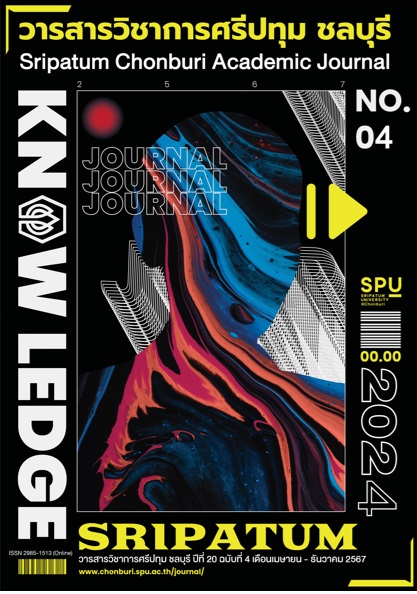TRANSPORTATION AND DISTRIBUTION MANAGEMENT FOR REDUCING FOOD LOSS: A CASE STUDY OF THE WOLFFIA SUPPLY CHAIN
Keywords:
Transportation and Distribution Management, Food Loss, WolffiaAbstract
This research aimed 1) to study the Wolffia supply chain, 2) to analyze losses throughout the supply chain, and 3) to propose transportation and distribution management methods using in-depth interviews with three Wolffia farmers, one manufacturer, and 28 customers related to the breeding process, storage, packaging, and delivery, as well as processing for loss analysis throughout the supply chain.
It was found that the transportation and distribution processes resulted in up to a 20% loss of Wolffia. The main cause was delivering the eggs from different provinces to customers in the city, which took at least 4 hours. Often, products were damaged due to delays and inadequate temperature control. The research proposed transportation and distribution management methods to reduce delivery time and ensure the fastest delivery to customers by establishing distribution centers in Bangkok. Through the central location selection method by comparing potential locations using distance and transportation cost calculations, two optimal locations were identified: the Phra Nakhon area (13.759923689101600, 100.564717795655000) and Thonburi area (13.691066931265300, 100.472623747179000), which could deliver products to customers within 60 minutes, reducing Wolffia losses at this stage.
References
กนกวรรณ กนกกุลชัย. (2562). ปัญหา “ขยะอาหาร” (Food Loss and Waste), วารสาร สนค., 96(9), หน้า 3-25.
กรมควบคุมมลพิษ. (2566). รายงานประจำปี 2566. กรุงเทพฯ: กรมควบคุมมลพิษ กระทรวงทรัพยากรธรรมชาติและสิ่งแวดล้อม.
ขจรศักดิ์ ไชยวงค์. (2560). แนวทางการเลือกทำเลที่ตั้งสาขาของศูนย์การค้ามหสรรพสินค้า. วิทยานิพนธ์วิทยาศาสตรมหาบัณฑิต สาขาวิชานวัตกรรมการพัฒนาอสังหาริมทรัพย์, คณะสถาปัตยกรรมศาสตร์และการผังเมือง มหาวิทยาลัยธรรมศาสตร์.
คำนาย อภิปรัชญาสกุล. (2559). การจัดการขนส่งและการกระจายสินค้าเชิงกลยุทธ์. กรุงเทพฯ: โฟกัสมีเดีย แอนด์ พับลิชชิ่ง.
ชรัญญา สุวรรณเสรีรักษ์ และเก็จวลี ศรีจันทร์. (2564). รูปแบบการจัดการห่วงโซ่อุปทานและรูปแบบการตลาดพืชผักปลอดภัยที่เหมาะสําหรับเกษตรกร อําเภอแม่แจ่ม จังหวัดเชียงใหม่. วารสารวิชาการวิทยาลัยบริหารศาสตร์, 4(1), หน้า 84-98.
ชลธิชา จันทิม และธรรมวิมล สุขเสริม. (2565). การศึกษาความเป็นไปได้ในการเลือกทำเลที่ตั้งโรงงานปาล์มน้ำมันในจังหวัดอุบลราชธานี. วารสารวิจัยวิทยาการจัดการ มหาวิทยาลัยราชภัฏสุรินทร์, 6(1), หน้า 31-43.
ธรินี มณีศรี และวิมลภา ชุ่มดี. (2566). การจัดการโลจิสติกส์และโซ่อุปทานเพื่อเป้าหมายการพัฒนาที่ยั่งยืน (SDGs) กรณีศึกษา: ผู้ผลิตสับปะรดกระป๋อง. วารสารสหศาสตร์ศรีปทุม ชลบุรี, 9(2), หน้า 62-76.
ผู้จัดการออนไลน์. (2566). สวก.หนุนงานวิจัยซูเปอร์ฟูด “ไข่ผำ” เป็นพืชโปรตีนทดแทน ตอบโจทย์คนรักสุขภาพทั่วโลก (ออนไลน์). เข้าถึงได้จาก: https://mgronline.com/local/detail/9660000047931 [2567, 24 พฤษภาคม].
วริศรา สุภา และขนิษฐา เรียนกระโทก. (2561). การตัดสินใจเลือกทำเลที่ตั้งคลังสินค้าของบริษัทจำหน่ายเคมีภัณฑ์. โครงงานวิศวกรรมศาสตรบัณฑิต สาขาวิชาวิศวกรรมการจัดการและโลจิสติกส์, วิทยาลัยนวัตกรรมด้านเทคโนโลยีและวิศวกรรมศาสตร์ มหาวิทยาลัยธุรกิจบัณฑิตย์.
สำนักงานเศรษฐกิจการเกษตร. (2563). การประเมินความสูญเสียอาหารผลิตภัณฑ์เกษตรและอาหารระดับชาติ. ใน การประชุมคณะกรรมการขับเคลื่อนด้านความมั่นคงอาหารตลอดห่วงโซ่ ครั้งที่ 1/2565 (หน้า 1-40). กรุงเทพฯ: กองเศรษฐกิจการเกษตรระหว่างประเทศ.
อรุชา อิทธิฉันทกิจ. (2558). การตัดสินใจเลือกทำเลที่ตั้งโรงงานผลิตเครื่องดื่มแห่งใหม่ (ออนไลน์). เข้าถึงได้จาก: http://library.tni.ac.th/thesis/upload/files/arucha%20Articles%20EEM%202015.pdf [2567, 11, มิถุนายน].
อรุณี รอดลอย, สุจินต์ หนูขวัญ, ศิริวิมล ติรณะรัต และมาลี เอี่ยมทรัพย์. (2552). รายงานการวิจัย ชนิดและการกระจายพันธุ์ของพรรณไม้น้ำในภาคตะวันออกของประเทศไทย. กรุงเทพฯ: กรมประมง.
Cattaneo, A., Sánchez, M. V., Torero, M., & Vos, R. (2021). Reducing food loss and waste: Five challenges for policy and research. Food Policy, 98(1), pp. 1-16.
Chantiratikul, A., Chinrasri, O., Chantiratikul, P., Sangdee, A., Maneechote, U., & Bunchasak, C. (2010). Effect of replacement of protein from soybean meal with protein from wolffia meal [Wolffia globosa (L). Wimm.] on performance and egg production in laying hens. International Journal of Poultry Science, 9(3), pp. 283-287.
Codex Alimentarius Commission. (2013). EU platform on Food Losses and Food Waste: Sub group on food waste measurement Brussels. Rome: Food and Agriculture Organization of the United Nations.
FAO. (2011). Global food losses and food waste extent, causes and prevention. Rome: Food and Agriculture Organization of the United Nations.
FAO. (2014). SAVE FOOD: Global Initiative on Food Loss and Waste Reduction: Definitional framework of food loss. Rome: Food and Agriculture Organization of the United Nations.
FAO. (2019). The state of food and agriculture 2019: Moving forward on food loss and waste Reduction. Rome: Food and Agriculture Organization of the United Nations.
FAO. (2020). SDG 12.3.1a:Food Loss Index. Rome: Food and Agriculture Organization of the United Nations.
Heizer, J., and Render, B. (2013). Operations Management (11th ed.). Upper Saddle River, NJ: Pearson Prentice Hall.
Parfitt, J., Barthel, M., & Macnaughton, S. (2010). Food waste within food supply chains: Quantification and potential for change to 2050. Philosophical Transactions of the Royal Society B: Biological Sciences, 365(1554), pp. 3065–3081.
O'Connor, J., Skeaff, S., Bremer, P., Lucci, G., & Mirosa, M. (2023). A critical review of on-farm food loss and waste: future research and policy recommendations. Renewable Agriculture and Food Systems, 38(24), pp. 1–12.
Downloads
Published
Issue
Section
License
Copyright (c) 2024 Sripatum University Chonburi Campus

This work is licensed under a Creative Commons Attribution-NonCommercial-NoDerivatives 4.0 International License.
บทความทุกบทความเป็นลิขสิทธิ์ของวารสารวิชาการศรีปทุม ชลบุรี



